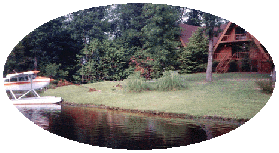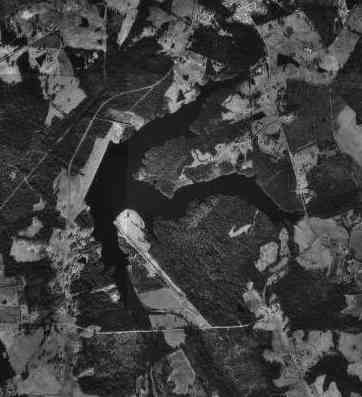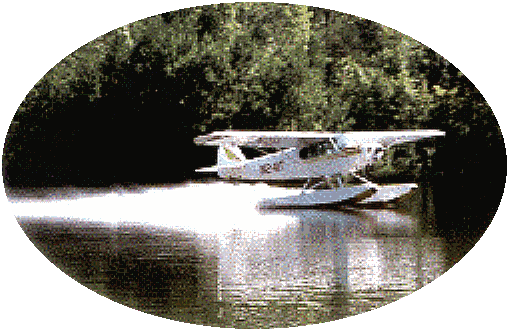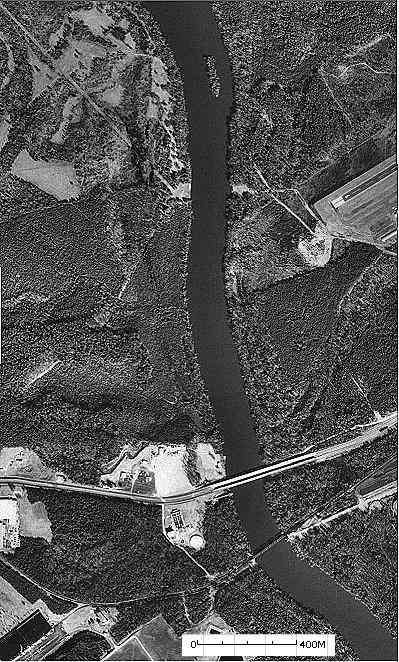Lesson 128-133
21-22 November 1999
Seaplane Rating
I've been thinking about seaplanes for a long time and finally decided
that I'd never be able to make any kind of reasonable decision until I
knew how to fly the things. A quick look around the Seaplane
Pilot's Association website showed me that there are only a few places
within a reasonable distance where I could get the training--three in Maryland
and one in South Carolina. They all offered comparable two-day courses,
most costing $700-$800, including the cost of the FAA checkride.
I checked them out and decided that the
South Carolina place, though about 100 miles farther away, looked the
most promising.  The late-fall weather was likely to be better there and the setting looked
very nice. It's Kirk
Air Base (T73), and is about 10 miles southeast of Lancaster, SC.
It's on a lake and has one paved runway and three water runways, and it
also has accommodations on the site. The instruction would be in
a Super Cub floatplane. A couple of emails and phone calls later
I was on their schedule for a few days before Thanksgiving. With
that in mind, I dug out the book on seaplane flying that I'd been reading
sort of wistfully off and on for nearly a year, and got into it seriously.
The late-fall weather was likely to be better there and the setting looked
very nice. It's Kirk
Air Base (T73), and is about 10 miles southeast of Lancaster, SC.
It's on a lake and has one paved runway and three water runways, and it
also has accommodations on the site. The instruction would be in
a Super Cub floatplane. A couple of emails and phone calls later
I was on their schedule for a few days before Thanksgiving. With
that in mind, I dug out the book on seaplane flying that I'd been reading
sort of wistfully off and on for nearly a year, and got into it seriously.
I can't write everything
here, but I'll try to give you
some idea of what the course entailed, what I experienced, and all.
Saturday, the 20th, was The Day. I hit the road at 9:30 in the
morning on Saturday, 20 November, and arrived in Lancaster, SC at 3:15.
T73 is a few miles southeast of Lancaster. I used my GPS to double
check my road map, and pulled into the airport driveway at 3:30, having
driven 358 miles from Richmond, VA.
 Here's
a detail from a USGS
aerial photo of T73 and environs. The unnaturally straight line
separating the dark lake from the light pasture is the dam. The light-colored
2600 foot paved runway, 15-33, points right toward the dam.
Here's
a detail from a USGS
aerial photo of T73 and environs. The unnaturally straight line
separating the dark lake from the light pasture is the dam. The light-colored
2600 foot paved runway, 15-33, points right toward the dam.
The first person I saw turned out to be Jim Kirk--the FBO, the seaplane
instructor, and an A&P, all in one versatile guy. He was changing
the oil in a Cessna 172 and sent me down the hill to the house, where his
wife Jane met me and showed me to my room in a wing of their house.
The instruction wasn't to begin until the next morning, so after chatting
with Jane for a few minutes I strolled down to the lake and had a look
at the Super Cub floatplane nosed up on shore beside a floating wooden
dock. Then I walked back up to the ramp and hung around watching
Jim work and got him talking about airplanes (not that he doesn't like
to talk about airplanes).
Jim is about 55. He attended Clemson for a while and then transferred
to Embry-Riddle,
where (if I got this right) he learned to fly and became an A&P mechanic.
He was in the army in the late sixties and was trained as an aircraft radio
repairman at Ft. Gordon, although in Vietnam he worked mainly as an A&P.
So we had a lot in common. I would have gone to Embry-Riddle if only
I'd known about it then, and I too was in radio school at Ft. Gordon and
was an aircraft radio repairman in Korea. (A digression: one
of my Ft. Gordon experiences.)
He told me about his friend Max, who had died recently of cancer.
Jim scattered his ashes from Lancaster to the ocean, as Max wished.
He did it by wrapping paper streamers around paper packets of ashes and
tossing them one by one out the window of the Super Cub. He said
the streamer would unwind, getting longer and longer and then there would
be a puff uf dust when the ashes came out. He said there was a bit
of Max's ashes scattered around on the ramp, too, and that he felt good
about it. I told him that I have some of my father's ashes in a Ziploc
bag in my desk.
The Kirks don't serve meals, so later on I drove into town for dinner
and to stock up on eats for breakfast.
Sunday, 21 November 1999. I had breakfast on the dock.
Low overcast, no wind, visibility maybe a mile. Ten or twelve Mallard ducks
didn't want me keeping them company and flew off from the marshy area left
of the dock, their wings making the still air whistle with every stroke.--wheep
wheep wheep wheep . Quiet. I hear a dry leaf fall. A small
grey bird is tapping in the top of a tree.
0900. Ground school first--an overview of seaplane flying, procedures
for normal water take offs and landings, the 150 hp Super Cub's flying
characteristics, and so on. Then the airplane.
Pump out the floats. Push off and tow it to the end of the dock.
Strap on a PFD. Get in and check things out Start on the left
mag only because the right mag lacks an impulse starter. The big
floatplane thing became obvious right away--NO BRAKES. As soon as
the first cylinder fired, we began moving.
Idle (displacement) taxi at 800 rpm. The rudder pedals are very
stiff because of the water rudders and linkage.
With the engine idling we taxi slowly around, and Jim says the first
thing landplane pilots want to do is go faster. But that causes spray
to get into the prop and erode it, and besides it's safer to go slowly,
especially if there's much wind. And of course, there's that NO BRAKES
thing to keep in mind. "Patience is a virtue in a floatplane," he
says. So we idle taxi. And do idle turns. When I can
do that with some confidence we throttle up to 1700 and check the mags
and the carb heat. Then it's time for--
CARS--Carb heat off, Area clear, water Rudders
up, Stick aft.
 Full
power, the nose comes up, then it comes up a second time, farther, ease
off the back pressure so the nose comes down and we can accelerate
to step taxi speed. Look for the sweet spot on the step. At
about 55 it's already flying. Ease the stick forward until we hit
70, then let it climb.
Full
power, the nose comes up, then it comes up a second time, farther, ease
off the back pressure so the nose comes down and we can accelerate
to step taxi speed. Look for the sweet spot on the step. At
about 55 it's already flying. Ease the stick forward until we hit
70, then let it climb.
At 1000 MSL--450 AGL--we hit the cloud bottom. It's Class G airspace,
Jim says, so we need only 1 mile and clear of the clouds. We have
about 5 miles and we are clear--so we postpone the air work and
go right to landings. Downwind, throttle to 1300 briefly and then
to idle. Base. Final, lining up with the longest arm of the
lake, coming in over some trees, more or less parallel to the dam.
Keep the airspeed at 70. Level off at about 10 feet, raise the nose
slightly to step-taxi attitude, and let it fly down onto the water.
Do that 7 more times. I level off a little high the second time,
a little low the third time, and then start getting the feel of it.
The three H's before docking--Headset off, Harness
off, Hatch (door) open,
Docking is like flying a normal landing pattern, preferably so that
you'll end up with your door alongside the dock. That's the right
side in a Super Cub. You go downwind and do the three H's, turn base
and slow as much as you can by pulling on the carb heat and switching the
mag to left. Turn final and line up the right float with the dock.
When you think the distance, your speed, and the wind are in the right
proportions, switch off the mag and coast up to the dock. Your passenger--Jim,
in this case--is on the float behind the strut (for safety), with the grab
line in hand, and hops onto the dock to tie up. If it's an unfamiliar
place, however, you first do a circuit around the pattern to check it out,
and then do it again to dock.
And it's time for lunch.
Lesson 2, that afternoon. After another ground school session,
we take off and fly about 20 miles south to a big lake for some rough water
practice. The trick here is to keep the nose slightly higher so that
the prop can better stay clear of the spray and so that the floats don't
dig into the waves. Takoffs begin normally, but as soon as you can,
you pull it into the air in surface effect by bouncing off a wave.
Then you lower the nose and accelerate until you can establish a positive
rate of climb. Landing is similar, with the nose kept slight higher
than for normal water landings. However, you still want to keep the
prop out of the spray, so as soon as you come off of the step into "plow"
mode, you add power to about 2000 rpm (in that Super Cub) to hold the nose
up. Then you can plow taxi into smooth water. When the wind
is strong, you can also do plow turns to get from upwind to downwind, because
the center of buoyance in that mode is far enough aft so that the floatplane
will weathervane with the nose downwind, instead of with it upwind as it
does in idle taxi mode. However, you don't want to plow for very
long because the engine is likely to over heat from the relatively high
rpm and low speed.
Jim showed me how to find a bay or inlet that is protected from the
wind and land and take off diagonally across it, partly across the wind,
in order to take advantage of the smoother water.
We also did step turns, in which you're taxiing on the step at maybe
35 mph and turn. That seems logical enough. The trick is that
even though you have the stick hard over in the direction of the turn,
the airplane is going to bank to the outside of the turn. So it feels
odd, and there's the increased danger of the wind picking up the inside
wing--because the outside float is lower in the water now--and capsizing
you. So it's especially tricky when turning from downwind to upwind.
We took a short break and then--
Lesson 3, glassy water landings and takeoffs. The problem
here is that when the water is smooth, you can't judge your height--period!--so
you have to keep in some power and let the floatplane fly itself down until
it lands.
Jim had me extend the downwind slightly, reduce power to 1500 rpm and
turn base. The idea is to aim at the LVP--the last visual point--the
last thing you can see to judge your altitude before you're over glassy
water. You absolutely can't tell where the surface of smooth water
is. (I proved that a couple of times.) In this case, the LVP
was a field at the edge of the lake. Jim had me turn final and then
cut the power and descend at 70 until about 100 feet AGL. At that
point the idea is to level off and transition to slow flight, 50 mph, advancing
the throttle to 1600 rpm to attain a sink rate of 150 feet per minute.
That seems straightforward--except that the Super Cub stalls at 45, giving
you only a 5 mph margin. And there's a utility pole at the downwind
end of that field, with wires running across your glidepath and you have
to pass maybe 30 feet above them. And of course you can't SEE them
pass below you--so I was not a little nervous during the first few glassy
water landings. We didn't hit the power lines, though, and I got
the hang of letting the airplane ease itself onto the water.
Landing over those wires turned out to be good experience the next day.
At some point in doing these takeoffs and landings, the most important
lesson of all happened to me. The CARS routine is important because
you want to be safe, and because you want to be sure that the water rudders
are down for idle and plow taxiing, but up for step taxiing and takeoffs
and landings. So I was going through the CARS routine, and I had
it down well. It was becoming automatic. But once, in transitioning
from idle taxi to step taxi and back several times, I somehow got out of
sequence. In preparing to take off, I moved the water rudders handle--automatically--but
they were already up and I moved them down. Now, it was a small thing,
and taking off with the water rudders down isn't dangerous. It creates
almost no extra drag, and the only hazard is that they might bounce up
and down and bang on the backs of the floats. So it wasn't dangerous--but
the point is, I did the wrong thing without thinking.
As I was doing CARS on downind, I discovered that the rudders were down.
When I mentioned it to Jim, he said he was letting me discover it all by
myself so I'd remember it. And he was right--I certainly do remember
it! And now I know why they say that the only pilots who haven't
made a wheels-up landing are those who haven't made a wheels-up landing
yet.
I
could just as easily have moved a landing gear lever the wrong way without
every thinking about what I was doing.
 Lesson
5, Monday 22 November, 0830. After more ground school, we took
off and flew beneath the 1500 foot clouds northwest around Lancaster and
past Lancaster County-McWhirter Field (LKR)
to the Catawba River. Here's a USGS aerial photo (slightly enhanced) of
the area: You can see the west end of McWhirter's runway near
the upper right. At the bottom of the picture there's a railroad
bridge and a four-lane highway bridge. Crossing the river just off
the McWhirter runway is a power line. The wind was light and from
the north. The problem was to land between the highway bridge and
the power line.
Lesson
5, Monday 22 November, 0830. After more ground school, we took
off and flew beneath the 1500 foot clouds northwest around Lancaster and
past Lancaster County-McWhirter Field (LKR)
to the Catawba River. Here's a USGS aerial photo (slightly enhanced) of
the area: You can see the west end of McWhirter's runway near
the upper right. At the bottom of the picture there's a railroad
bridge and a four-lane highway bridge. Crossing the river just off
the McWhirter runway is a power line. The wind was light and from
the north. The problem was to land between the highway bridge and
the power line.
First we dragged the river, flying above it at 200 feet looking for
floating logs, sand bars, boats, and other things that could cause us to
swim. Then it was time to land.
Jim had me fly a right-hand pattern, with the downwind leg parallel
to the river and crossing over McWhirter's numbers. At the railroad,
I dropped the power to idle and turned right base. Over the middle
of the river we turned final and at Jim's insistance I gritted my teeth
and passed over the bridge with about 50 feet to spare. That's 50
feet above the bridge. The tops of trucks were somewhat higher
than the road surface. Whew! After clearing the bridge, the
landing was easy, although Jim said to keep to the center or a little left
of it because there was probably a downdraft coming off the trees along
the right bank.
Contrary to what I'd thought at first, there was plenty of room.
We step-taxiied at 1900 rpm until the power lines were above the windshield,
then throttled up the rest of the way and took off, turning gently to the
left of the island, climbing out along the main channel of the river.
Jim had me repeat that about 8 or 10 times, until I could do it without
losing tooth emamel. Then we flew back to his lake for more practice
at plow turns, sailing downwind, beaching, and docking.
As a sort of finale, Jim demonstrated a confined area takeoff and landing.
He step-taxiied downwind in the basin by the dam, turned left (using P-factor
to assist in the turn) until we were heading upwind and had enough speed
to fly, and took off. His landing was the reverse--he landed upwind
and immediately began a left step-taxi turn to get back enough room to
slow down without hitting anything. It was great fun--although a
bit scary, as he used up almost every foot of water in those maneuvers,
and for that reason he declined to let me try it. Probably just as
well. It was time for lunch, anyway.
FAA Checkride.
While we were at lunch, the examiner had been up with a student who
had already failed his private pilot checkride twice. The student
had looked awfully grim, preflighting a 152 as we drove past in Jim's big
pickup. When we got back, the examiner was just walking down toward
the lake, looking sorrowful and shaking his head. The student was
heading toward his car and wouldn't look at us.
Oh oh. This doesn't look the least bit auspiscious.
The examiner and Jim conferred for a while, both looking uncomfortable.
And then it was my turn.
But the examiner turned out to be a lovely man, and I felt comfortable--for
a checkride!--the whole time. He grilled me about all the floatplane
things--characteristics of the Super Cub, how to do normal, rough, and
glassy water landings and takeoffs, how to dock, how to beach--all those
things Jim had had me jam into my head. Then we went down to the
lake, climbed into the Super Cub, and it all became very real. First
he had me do some steep turns and I was able to keep well within the 100
foot limit. Then he had me demonstrate everything Jim had taught
me--normal, rough, and glassy water takeoffs and landings, the varous modes
of taxiing, docking, and beaching--everything.
And now I'm carrying around a brand new Temporary Airman Certificate
inscribed "AIRPLANE SINGLE ENGINE LAND AND SEA." And I have 0.9 hours
of seaplane PIC time in my logbook.
And yes, I know--this new rating is really just a brand new license
to learn.
Here are some of this floatplane's specifications:
Piper PA-18 Super Cub N241T, 150 hp, Aqua 1900 floats
Normal Landing: idle rpm, 70 mph.
Rough water landing: Idle rpm. On touchdown throttle up
to 1300 rpm. On achieving plow mode, increase to 2000 rpm and plow
taxi to smoother water.
Glassy water landing: 70 mph approach, 1500 rpm--to ìdle--to
LVR, slow to 50 mph, then power to 1600 rpm until touchdown.
Step taxi: Full power until second hump, then 1900 rpm.
Increase about 100 rpm in turns.
Cruise: 2300 rpm.
GW 1760
EW 1290
UL 470
Fuel: 36 gals, 6.2 gph = 5.5+ hrs = 5 hrs + .5 hr reserve
Back to "Learning Flying"
My home page.
 The late-fall weather was likely to be better there and the setting looked
very nice. It's Kirk
Air Base (T73), and is about 10 miles southeast of Lancaster, SC.
It's on a lake and has one paved runway and three water runways, and it
also has accommodations on the site. The instruction would be in
a Super Cub floatplane. A couple of emails and phone calls later
I was on their schedule for a few days before Thanksgiving. With
that in mind, I dug out the book on seaplane flying that I'd been reading
sort of wistfully off and on for nearly a year, and got into it seriously.
The late-fall weather was likely to be better there and the setting looked
very nice. It's Kirk
Air Base (T73), and is about 10 miles southeast of Lancaster, SC.
It's on a lake and has one paved runway and three water runways, and it
also has accommodations on the site. The instruction would be in
a Super Cub floatplane. A couple of emails and phone calls later
I was on their schedule for a few days before Thanksgiving. With
that in mind, I dug out the book on seaplane flying that I'd been reading
sort of wistfully off and on for nearly a year, and got into it seriously.
 Here's
a detail from a
Here's
a detail from a  Full
power, the nose comes up, then it comes up a second time, farther, ease
off the back pressure so the nose comes down and we can accelerate
to step taxi speed. Look for the sweet spot on the step. At
about 55 it's already flying. Ease the stick forward until we hit
70, then let it climb.
Full
power, the nose comes up, then it comes up a second time, farther, ease
off the back pressure so the nose comes down and we can accelerate
to step taxi speed. Look for the sweet spot on the step. At
about 55 it's already flying. Ease the stick forward until we hit
70, then let it climb.